Abstract
In an uncontrolled study, vancomycin pharmacokinetics were determined in four normal (total body weight [TBW], 65.9 to 89.1 kg) and six morbidly obese (TBW, 111.4 to 226.4 kg) subjects. The morbidly obese subjects were investigated 3 to 4 h after gastric bypass surgery. Mean terminal half-lives, volumes of distribution, and total body clearances for the normal controls and the morbidly obese (TBW, 111.4 to 226.4 kg) subjects. The morbidly obese subjects were investigated 3 to 4 h after gastric bypass surgery. Mean terminal half-lives, volumes of distribution, and total body clearances for the normal controls and the morbidly obese subjects were 4.8 h, 0.39 liter/kg, and 1.085 ml/min per kg versus 3.2 h, 0.26 liter/kg TBW, and 1.112 ml/min per kg TBW. The mean terminal half-life and volume of distribution values were significantly different between the two groups. Strong correlations were found between TBW and both volume of distribution (correlation coefficient, 0.943) and total body clearance (correlation coefficient, 0.981). There results implied that TBW should be used to calculate vancomycin doses for morbidly obese patients. This was supported by the finding that there was no significant difference in the daily dose (in milligrams per kilogram per day) required to produce an average steady-state concentration of 15 micrograms/ml in the two groups (23.4 +/- 1.5 mg/kg per day for normal weight subjects and 24.0 +/- 3.4 mg/kg per day TBW for the postsurgery morbidly obese subjects). Therefore, the morbidly obese required higher total doses (in milligrams per day) than did normal weight subjects to achieve the same mean steady-state concentrations. In addition, normal weight and morbidly obese subjects had similar volumes of the central compartment (7.7 and 6.4 liters, respectively). To avoid high transient peak concentrations which would occur when obese patients are given larger total doses (in milligrams per day), maintenance doses may be given at more frequent intervals. The shorter mean terminal half-lives observed in morbidly obese patients allows more frequent dosing without excessive accumulation.
Full text
PDF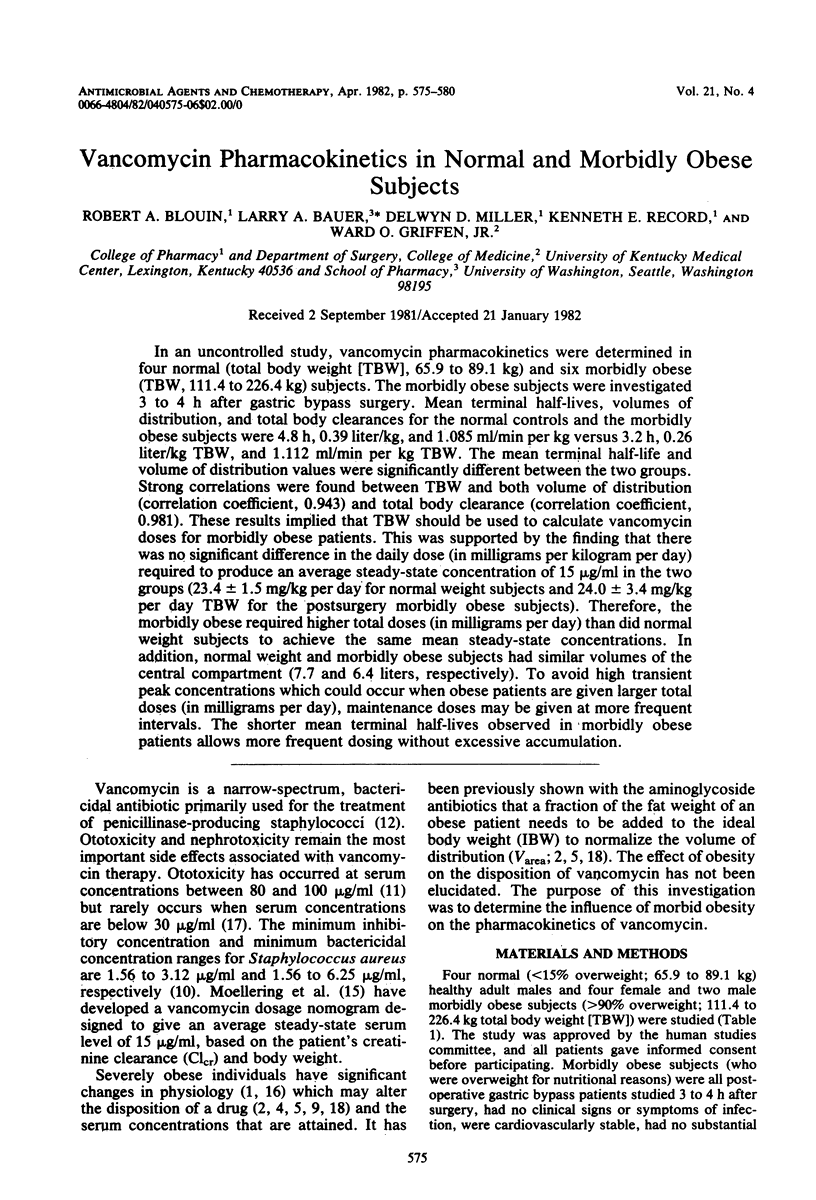
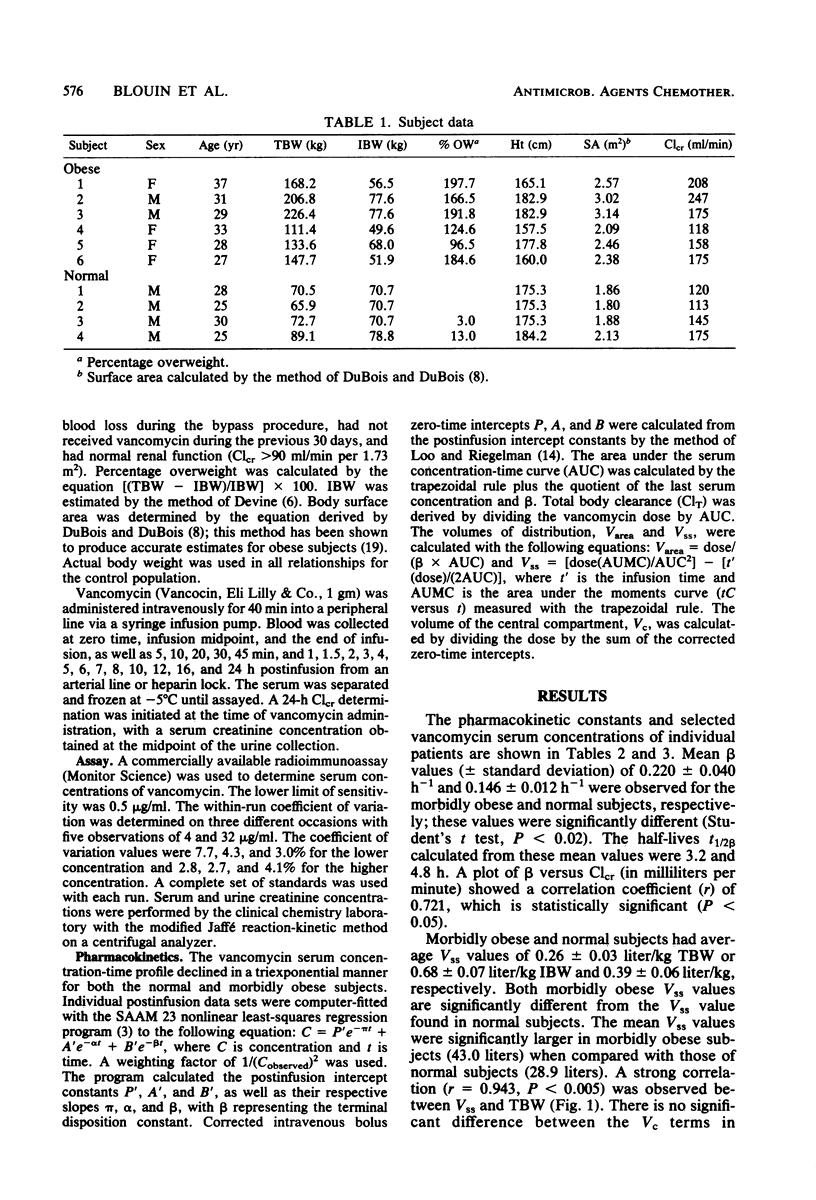
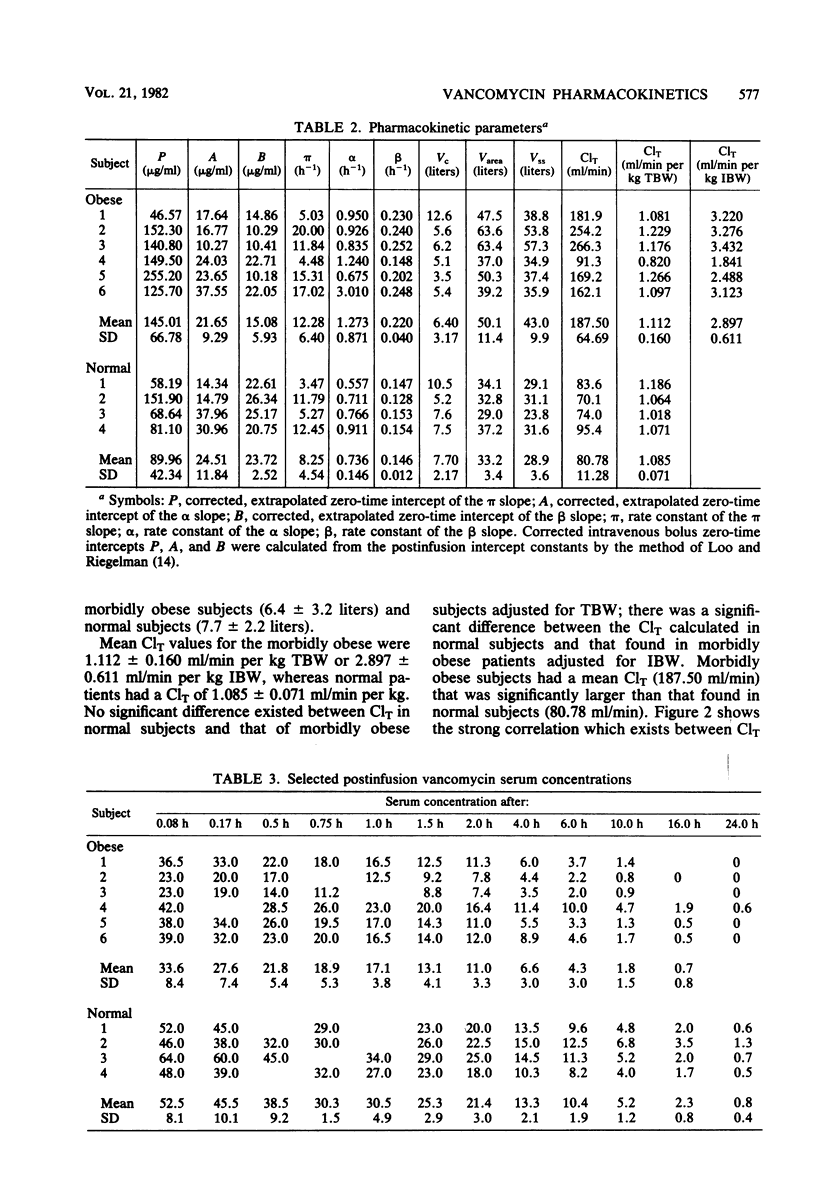
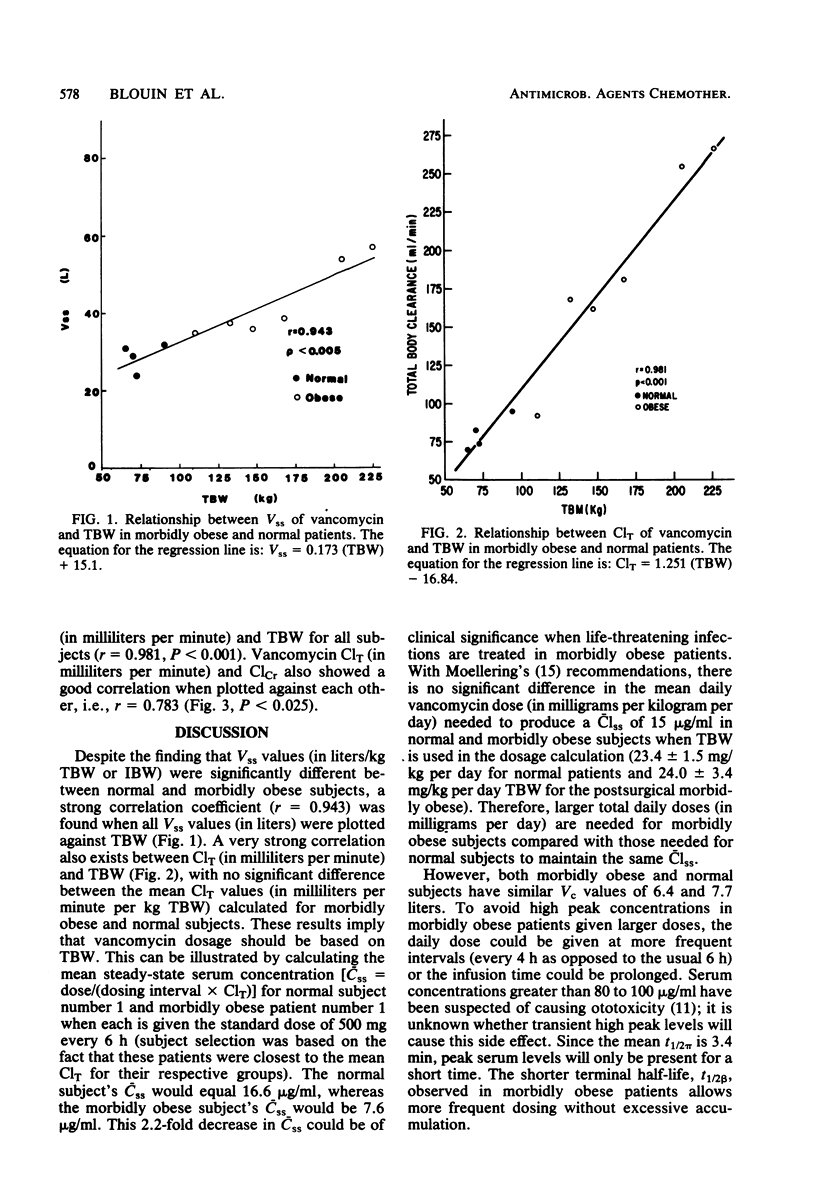
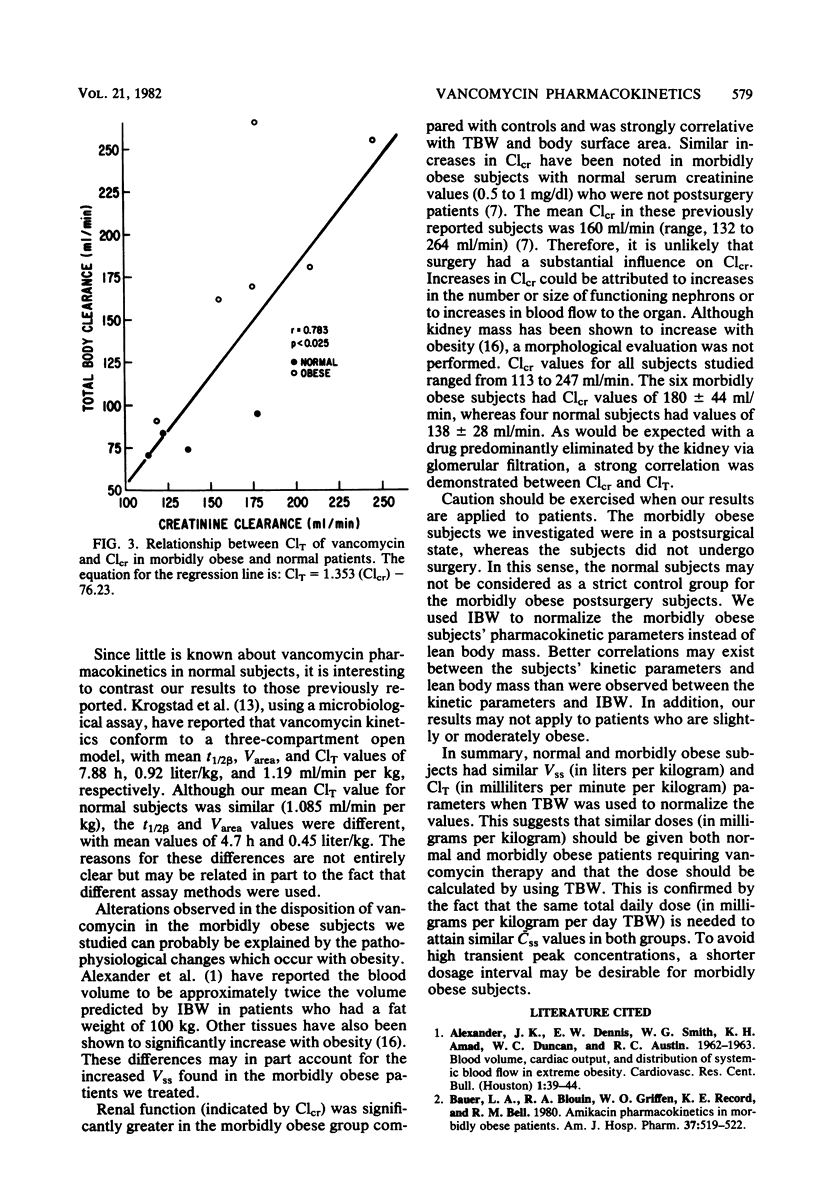
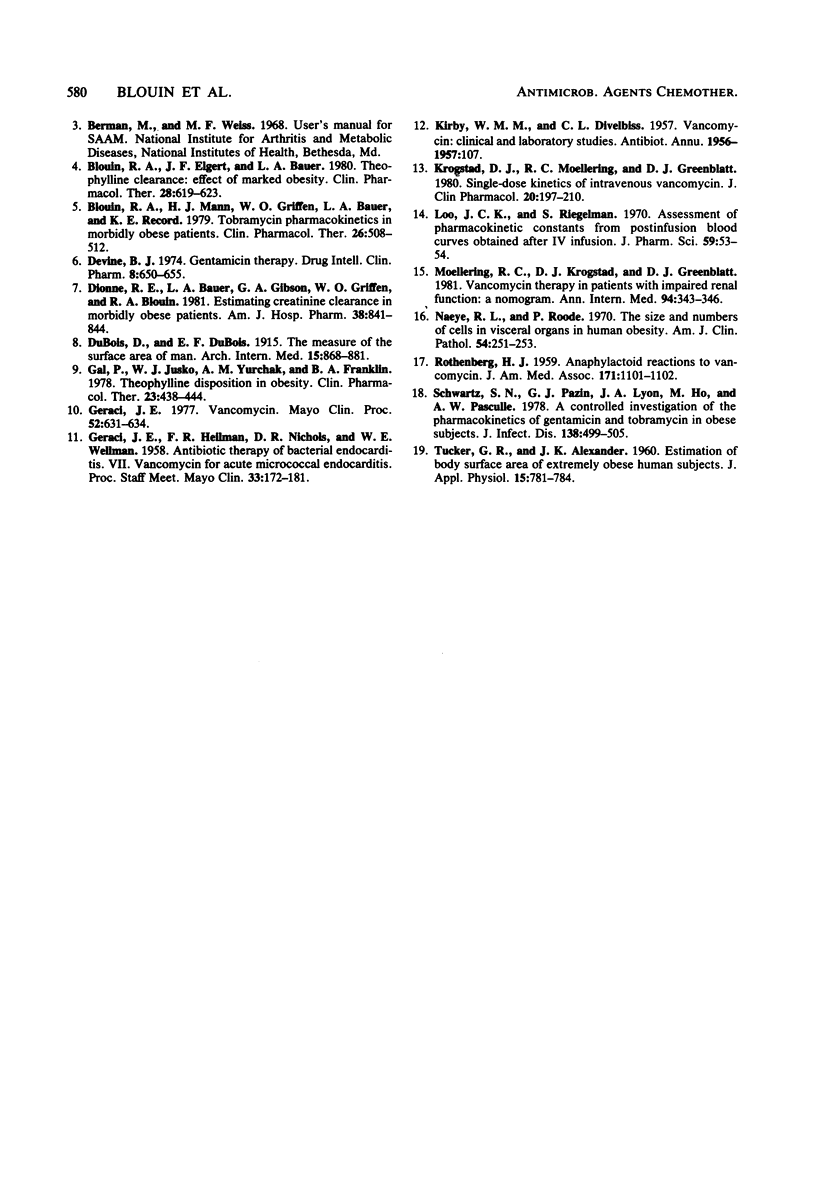
Selected References
These references are in PubMed. This may not be the complete list of references from this article.
- ALEXANDER J. K., DENNIS E. W., SMITH W. G., AMAD K. H., DUNCAN W. C., AUSTIN R. C. Blood volume, cardiac output, and distribution of systemic blood flow in extreme obesity. Cardiovasc Res Cent Bull. 1962;1:39–44. [PubMed] [Google Scholar]
- Bauer L. A., Blouin R. A., Griffen W. O., Jr, Record K. E., Bell R. M. Amikacin pharmacokinetics in morbidly obese patients. Am J Hosp Pharm. 1980 Apr;37(4):519–522. [PubMed] [Google Scholar]
- Blouin R. A., Elgert J. F., Bauer L. A. Theophylline clearance: effect of marked obesity. Clin Pharmacol Ther. 1980 Nov;28(5):619–623. doi: 10.1038/clpt.1980.212. [DOI] [PubMed] [Google Scholar]
- Blouin R. A., Mann H. J., Griffen W. O., Jr, Bauer L. A., Record K. E. Tobramycin pharmacokinetics in morbidly obese patients. Clin Pharmacol Ther. 1979 Oct;26(4):508–512. doi: 10.1002/cpt1979264508. [DOI] [PubMed] [Google Scholar]
- Dionne R. E., Bauer L. A., Gibson G. A., Griffen W. O., Jr, Blouin R. A. Estimating creatinine clearance in morbidity obese patients. Am J Hosp Pharm. 1981 Jun;38(6):841–844. [PubMed] [Google Scholar]
- GERACI J. E., HEILMAN F. R., NICHOLS D. R., WELLMAN W. E. Antibiotic therapy of bacterial endocarditis. VII. Vancomycin for acute micrococcal endocarditis; preliminary report. Proc Staff Meet Mayo Clin. 1958 Apr 2;33(7):172–181. [PubMed] [Google Scholar]
- Gal P., Jusko W. J., Yurchak A. M., Franklin B. A. Theophylline disposition in obesity. Clin Pharmacol Ther. 1978 Apr;23(4):438–444. doi: 10.1002/cpt1978234438. [DOI] [PubMed] [Google Scholar]
- Geraci J. E. Vancomycin. Mayo Clin Proc. 1977 Oct;52(10):631–634. [PubMed] [Google Scholar]
- KIRBY W. M., DIVELBISS C. L. Vancomycin; clinical and laboratory studies. Antibiot Annu. 1956:107–117. [PubMed] [Google Scholar]
- Krogstad D. J., Moellering R. C., Jr, Greenblatt D. J. Single-dose kinetics of intravenous vancomycin. J Clin Pharmacol. 1980 Apr;20(4 Pt 1):197–201. doi: 10.1002/j.1552-4604.1980.tb01696.x. [DOI] [PubMed] [Google Scholar]
- Loo J. C., Riegelman S. Assessment of pharmacokinetic constants from postinfusion blood curves obtained after I.V. infusion. J Pharm Sci. 1970 Jan;59(1):53–55. doi: 10.1002/jps.2600590107. [DOI] [PubMed] [Google Scholar]
- Moellering R. C., Jr, Krogstad D. J., Greenblatt D. J. Vancomycin therapy in patients with impaired renal function: a nomogram for dosage. Ann Intern Med. 1981 Mar;94(3):343–346. doi: 10.7326/0003-4819-94-3-343. [DOI] [PubMed] [Google Scholar]
- Naeye R. L., Roode P. The sizes and numbers of cells in visceral organs in human obesity. Am J Clin Pathol. 1970 Aug;54(2):251–253. doi: 10.1093/ajcp/54.2.251. [DOI] [PubMed] [Google Scholar]
- ROTHENBERG H. J. Anaphylactoid reaction to vancomycin. J Am Med Assoc. 1959 Oct 24;171:1101–1102. doi: 10.1001/jama.1959.73010260008010b. [DOI] [PubMed] [Google Scholar]
- Schwartz S. N., Pazin G. J., Lyon J. A., Ho M., Pasculle A. W. A controlled investigation of the pharmacokinetics of gentamicin and tobramycin in obese subjects. J Infect Dis. 1978 Oct;138(4):499–505. doi: 10.1093/infdis/138.4.499. [DOI] [PubMed] [Google Scholar]
- TUCKER G. R., ALEXANDER J. K. Estimation of body surface area of extremely obese human subjects. J Appl Physiol. 1960 Sep;15:781–784. doi: 10.1152/jappl.1960.15.5.781. [DOI] [PubMed] [Google Scholar]


